CPCCBC5018A - Structural Principles of Portal Steel Frame Construction
VerifiedAdded on 2023/05/30
|12
|2232
|337
Report
AI Summary
This report provides a detailed analysis of the structural principles applied to medium-rise portal steel frame construction, focusing on key elements such as columns, rafters, footings, and connections. It identifies the building classification according to the National Construction Code (NCC) of Australia, specifying it as Class 1, and discusses the importance of footing systems in maintaining structural stability. The report also outlines the structural connection sequence, site management processes during erection, and various connection methods like base connections and knee joints. Furthermore, it examines purlin and girt selection, installation methods, wall and roof bracing techniques, and provides a sketch analyzing major structural loading effects on portal frames. The analysis concludes with an evaluation of cladding and its connection methods, offering a comprehensive overview of the structural considerations in medium-rise construction. Desklib offers a range of solved assignments and past papers for students.

Apply Structural Principles to the Construction of Medium Rise Building 1
Apply Structural Principles to the Construction of Medium Rise Building
by Student’s Name
Code + Course Name
Professor’s Name
University Name
City, State
Date
Apply Structural Principles to the Construction of Medium Rise Building
by Student’s Name
Code + Course Name
Professor’s Name
University Name
City, State
Date
Paraphrase This Document
Need a fresh take? Get an instant paraphrase of this document with our AI Paraphraser
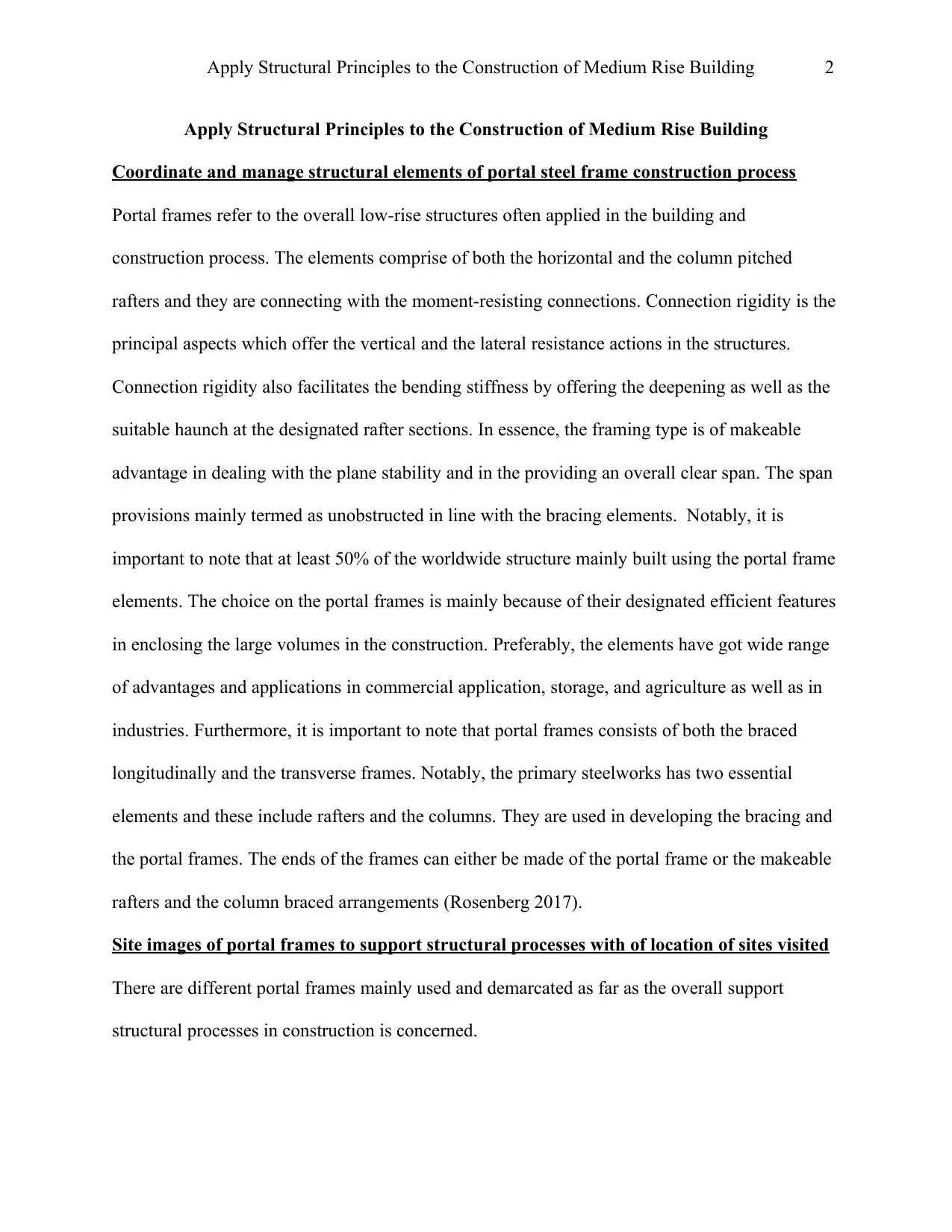
Apply Structural Principles to the Construction of Medium Rise Building 2
Apply Structural Principles to the Construction of Medium Rise Building
Coordinate and manage structural elements of portal steel frame construction process
Portal frames refer to the overall low-rise structures often applied in the building and
construction process. The elements comprise of both the horizontal and the column pitched
rafters and they are connecting with the moment-resisting connections. Connection rigidity is the
principal aspects which offer the vertical and the lateral resistance actions in the structures.
Connection rigidity also facilitates the bending stiffness by offering the deepening as well as the
suitable haunch at the designated rafter sections. In essence, the framing type is of makeable
advantage in dealing with the plane stability and in the providing an overall clear span. The span
provisions mainly termed as unobstructed in line with the bracing elements. Notably, it is
important to note that at least 50% of the worldwide structure mainly built using the portal frame
elements. The choice on the portal frames is mainly because of their designated efficient features
in enclosing the large volumes in the construction. Preferably, the elements have got wide range
of advantages and applications in commercial application, storage, and agriculture as well as in
industries. Furthermore, it is important to note that portal frames consists of both the braced
longitudinally and the transverse frames. Notably, the primary steelworks has two essential
elements and these include rafters and the columns. They are used in developing the bracing and
the portal frames. The ends of the frames can either be made of the portal frame or the makeable
rafters and the column braced arrangements (Rosenberg 2017).
Site images of portal frames to support structural processes with of location of sites visited
There are different portal frames mainly used and demarcated as far as the overall support
structural processes in construction is concerned.
Apply Structural Principles to the Construction of Medium Rise Building
Coordinate and manage structural elements of portal steel frame construction process
Portal frames refer to the overall low-rise structures often applied in the building and
construction process. The elements comprise of both the horizontal and the column pitched
rafters and they are connecting with the moment-resisting connections. Connection rigidity is the
principal aspects which offer the vertical and the lateral resistance actions in the structures.
Connection rigidity also facilitates the bending stiffness by offering the deepening as well as the
suitable haunch at the designated rafter sections. In essence, the framing type is of makeable
advantage in dealing with the plane stability and in the providing an overall clear span. The span
provisions mainly termed as unobstructed in line with the bracing elements. Notably, it is
important to note that at least 50% of the worldwide structure mainly built using the portal frame
elements. The choice on the portal frames is mainly because of their designated efficient features
in enclosing the large volumes in the construction. Preferably, the elements have got wide range
of advantages and applications in commercial application, storage, and agriculture as well as in
industries. Furthermore, it is important to note that portal frames consists of both the braced
longitudinally and the transverse frames. Notably, the primary steelworks has two essential
elements and these include rafters and the columns. They are used in developing the bracing and
the portal frames. The ends of the frames can either be made of the portal frame or the makeable
rafters and the column braced arrangements (Rosenberg 2017).
Site images of portal frames to support structural processes with of location of sites visited
There are different portal frames mainly used and demarcated as far as the overall support
structural processes in construction is concerned.
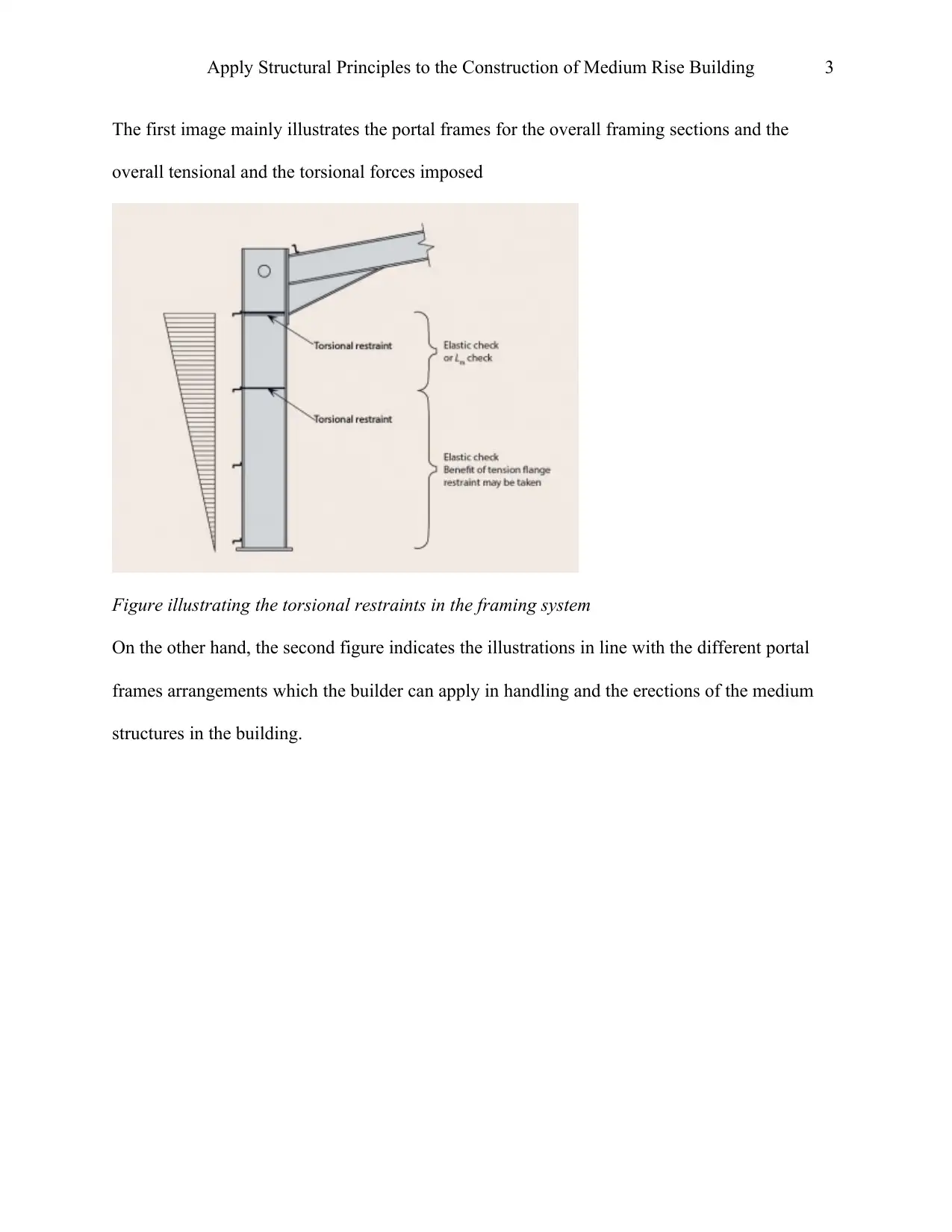
Apply Structural Principles to the Construction of Medium Rise Building 3
The first image mainly illustrates the portal frames for the overall framing sections and the
overall tensional and the torsional forces imposed
Figure illustrating the torsional restraints in the framing system
On the other hand, the second figure indicates the illustrations in line with the different portal
frames arrangements which the builder can apply in handling and the erections of the medium
structures in the building.
The first image mainly illustrates the portal frames for the overall framing sections and the
overall tensional and the torsional forces imposed
Figure illustrating the torsional restraints in the framing system
On the other hand, the second figure indicates the illustrations in line with the different portal
frames arrangements which the builder can apply in handling and the erections of the medium
structures in the building.
⊘ This is a preview!⊘
Do you want full access?
Subscribe today to unlock all pages.

Trusted by 1+ million students worldwide
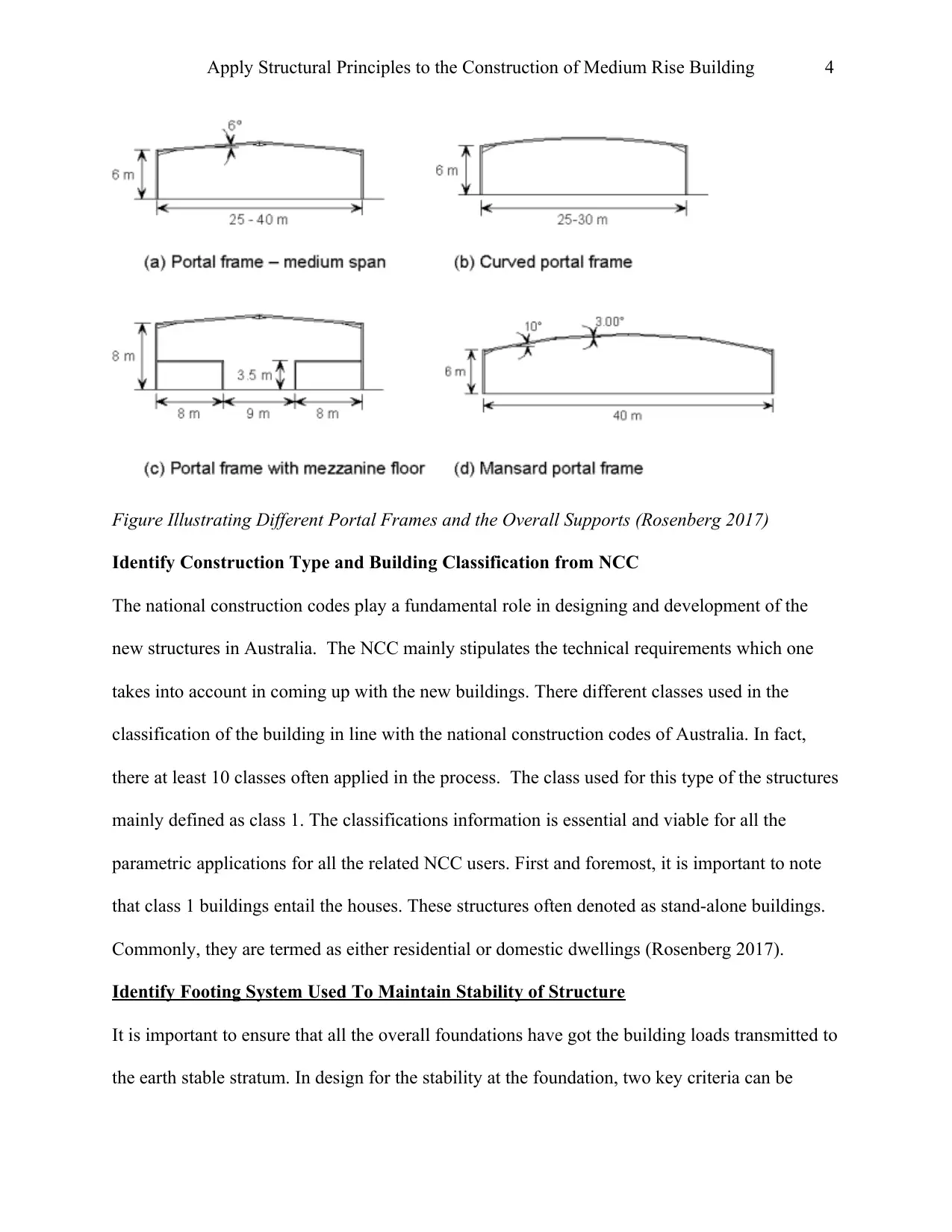
Apply Structural Principles to the Construction of Medium Rise Building 4
Figure Illustrating Different Portal Frames and the Overall Supports (Rosenberg 2017)
Identify Construction Type and Building Classification from NCC
The national construction codes play a fundamental role in designing and development of the
new structures in Australia. The NCC mainly stipulates the technical requirements which one
takes into account in coming up with the new buildings. There different classes used in the
classification of the building in line with the national construction codes of Australia. In fact,
there at least 10 classes often applied in the process. The class used for this type of the structures
mainly defined as class 1. The classifications information is essential and viable for all the
parametric applications for all the related NCC users. First and foremost, it is important to note
that class 1 buildings entail the houses. These structures often denoted as stand-alone buildings.
Commonly, they are termed as either residential or domestic dwellings (Rosenberg 2017).
Identify Footing System Used To Maintain Stability of Structure
It is important to ensure that all the overall foundations have got the building loads transmitted to
the earth stable stratum. In design for the stability at the foundation, two key criteria can be
Figure Illustrating Different Portal Frames and the Overall Supports (Rosenberg 2017)
Identify Construction Type and Building Classification from NCC
The national construction codes play a fundamental role in designing and development of the
new structures in Australia. The NCC mainly stipulates the technical requirements which one
takes into account in coming up with the new buildings. There different classes used in the
classification of the building in line with the national construction codes of Australia. In fact,
there at least 10 classes often applied in the process. The class used for this type of the structures
mainly defined as class 1. The classifications information is essential and viable for all the
parametric applications for all the related NCC users. First and foremost, it is important to note
that class 1 buildings entail the houses. These structures often denoted as stand-alone buildings.
Commonly, they are termed as either residential or domestic dwellings (Rosenberg 2017).
Identify Footing System Used To Maintain Stability of Structure
It is important to ensure that all the overall foundations have got the building loads transmitted to
the earth stable stratum. In design for the stability at the foundation, two key criteria can be
Paraphrase This Document
Need a fresh take? Get an instant paraphrase of this document with our AI Paraphraser
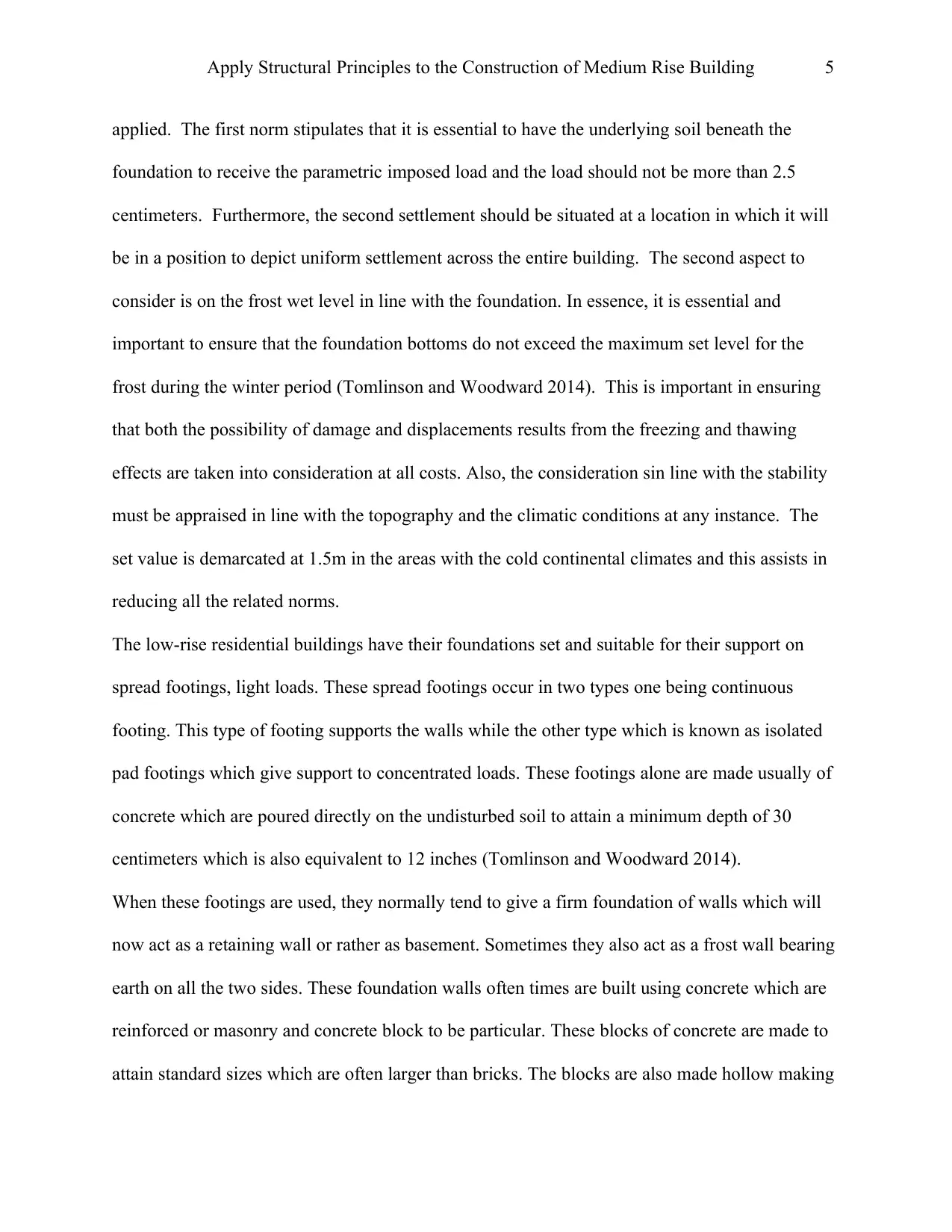
Apply Structural Principles to the Construction of Medium Rise Building 5
applied. The first norm stipulates that it is essential to have the underlying soil beneath the
foundation to receive the parametric imposed load and the load should not be more than 2.5
centimeters. Furthermore, the second settlement should be situated at a location in which it will
be in a position to depict uniform settlement across the entire building. The second aspect to
consider is on the frost wet level in line with the foundation. In essence, it is essential and
important to ensure that the foundation bottoms do not exceed the maximum set level for the
frost during the winter period (Tomlinson and Woodward 2014). This is important in ensuring
that both the possibility of damage and displacements results from the freezing and thawing
effects are taken into consideration at all costs. Also, the consideration sin line with the stability
must be appraised in line with the topography and the climatic conditions at any instance. The
set value is demarcated at 1.5m in the areas with the cold continental climates and this assists in
reducing all the related norms.
The low-rise residential buildings have their foundations set and suitable for their support on
spread footings, light loads. These spread footings occur in two types one being continuous
footing. This type of footing supports the walls while the other type which is known as isolated
pad footings which give support to concentrated loads. These footings alone are made usually of
concrete which are poured directly on the undisturbed soil to attain a minimum depth of 30
centimeters which is also equivalent to 12 inches (Tomlinson and Woodward 2014).
When these footings are used, they normally tend to give a firm foundation of walls which will
now act as a retaining wall or rather as basement. Sometimes they also act as a frost wall bearing
earth on all the two sides. These foundation walls often times are built using concrete which are
reinforced or masonry and concrete block to be particular. These blocks of concrete are made to
attain standard sizes which are often larger than bricks. The blocks are also made hollow making
applied. The first norm stipulates that it is essential to have the underlying soil beneath the
foundation to receive the parametric imposed load and the load should not be more than 2.5
centimeters. Furthermore, the second settlement should be situated at a location in which it will
be in a position to depict uniform settlement across the entire building. The second aspect to
consider is on the frost wet level in line with the foundation. In essence, it is essential and
important to ensure that the foundation bottoms do not exceed the maximum set level for the
frost during the winter period (Tomlinson and Woodward 2014). This is important in ensuring
that both the possibility of damage and displacements results from the freezing and thawing
effects are taken into consideration at all costs. Also, the consideration sin line with the stability
must be appraised in line with the topography and the climatic conditions at any instance. The
set value is demarcated at 1.5m in the areas with the cold continental climates and this assists in
reducing all the related norms.
The low-rise residential buildings have their foundations set and suitable for their support on
spread footings, light loads. These spread footings occur in two types one being continuous
footing. This type of footing supports the walls while the other type which is known as isolated
pad footings which give support to concentrated loads. These footings alone are made usually of
concrete which are poured directly on the undisturbed soil to attain a minimum depth of 30
centimeters which is also equivalent to 12 inches (Tomlinson and Woodward 2014).
When these footings are used, they normally tend to give a firm foundation of walls which will
now act as a retaining wall or rather as basement. Sometimes they also act as a frost wall bearing
earth on all the two sides. These foundation walls often times are built using concrete which are
reinforced or masonry and concrete block to be particular. These blocks of concrete are made to
attain standard sizes which are often larger than bricks. The blocks are also made hollow making
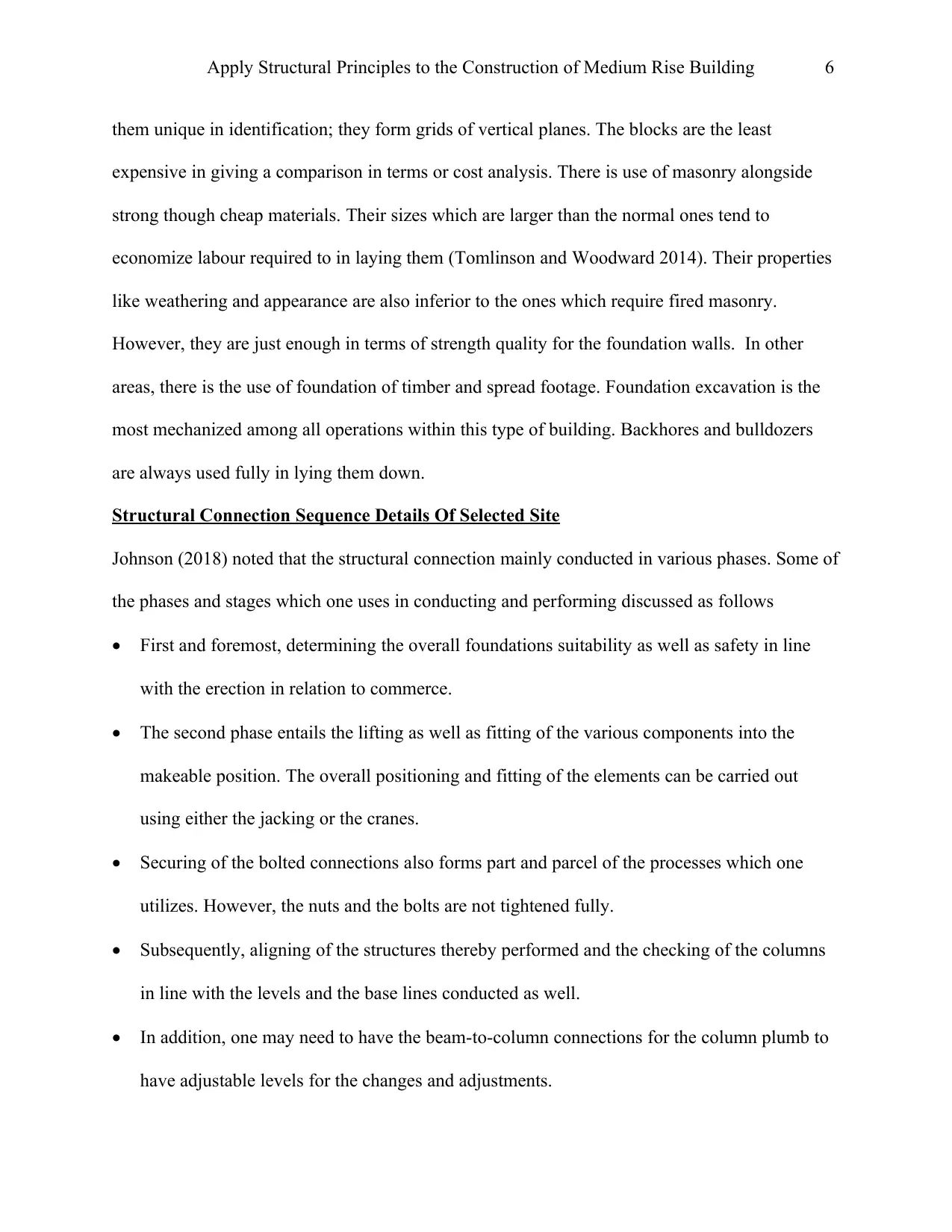
Apply Structural Principles to the Construction of Medium Rise Building 6
them unique in identification; they form grids of vertical planes. The blocks are the least
expensive in giving a comparison in terms or cost analysis. There is use of masonry alongside
strong though cheap materials. Their sizes which are larger than the normal ones tend to
economize labour required to in laying them (Tomlinson and Woodward 2014). Their properties
like weathering and appearance are also inferior to the ones which require fired masonry.
However, they are just enough in terms of strength quality for the foundation walls. In other
areas, there is the use of foundation of timber and spread footage. Foundation excavation is the
most mechanized among all operations within this type of building. Backhores and bulldozers
are always used fully in lying them down.
Structural Connection Sequence Details Of Selected Site
Johnson (2018) noted that the structural connection mainly conducted in various phases. Some of
the phases and stages which one uses in conducting and performing discussed as follows
First and foremost, determining the overall foundations suitability as well as safety in line
with the erection in relation to commerce.
The second phase entails the lifting as well as fitting of the various components into the
makeable position. The overall positioning and fitting of the elements can be carried out
using either the jacking or the cranes.
Securing of the bolted connections also forms part and parcel of the processes which one
utilizes. However, the nuts and the bolts are not tightened fully.
Subsequently, aligning of the structures thereby performed and the checking of the columns
in line with the levels and the base lines conducted as well.
In addition, one may need to have the beam-to-column connections for the column plumb to
have adjustable levels for the changes and adjustments.
them unique in identification; they form grids of vertical planes. The blocks are the least
expensive in giving a comparison in terms or cost analysis. There is use of masonry alongside
strong though cheap materials. Their sizes which are larger than the normal ones tend to
economize labour required to in laying them (Tomlinson and Woodward 2014). Their properties
like weathering and appearance are also inferior to the ones which require fired masonry.
However, they are just enough in terms of strength quality for the foundation walls. In other
areas, there is the use of foundation of timber and spread footage. Foundation excavation is the
most mechanized among all operations within this type of building. Backhores and bulldozers
are always used fully in lying them down.
Structural Connection Sequence Details Of Selected Site
Johnson (2018) noted that the structural connection mainly conducted in various phases. Some of
the phases and stages which one uses in conducting and performing discussed as follows
First and foremost, determining the overall foundations suitability as well as safety in line
with the erection in relation to commerce.
The second phase entails the lifting as well as fitting of the various components into the
makeable position. The overall positioning and fitting of the elements can be carried out
using either the jacking or the cranes.
Securing of the bolted connections also forms part and parcel of the processes which one
utilizes. However, the nuts and the bolts are not tightened fully.
Subsequently, aligning of the structures thereby performed and the checking of the columns
in line with the levels and the base lines conducted as well.
In addition, one may need to have the beam-to-column connections for the column plumb to
have adjustable levels for the changes and adjustments.
⊘ This is a preview!⊘
Do you want full access?
Subscribe today to unlock all pages.

Trusted by 1+ million students worldwide
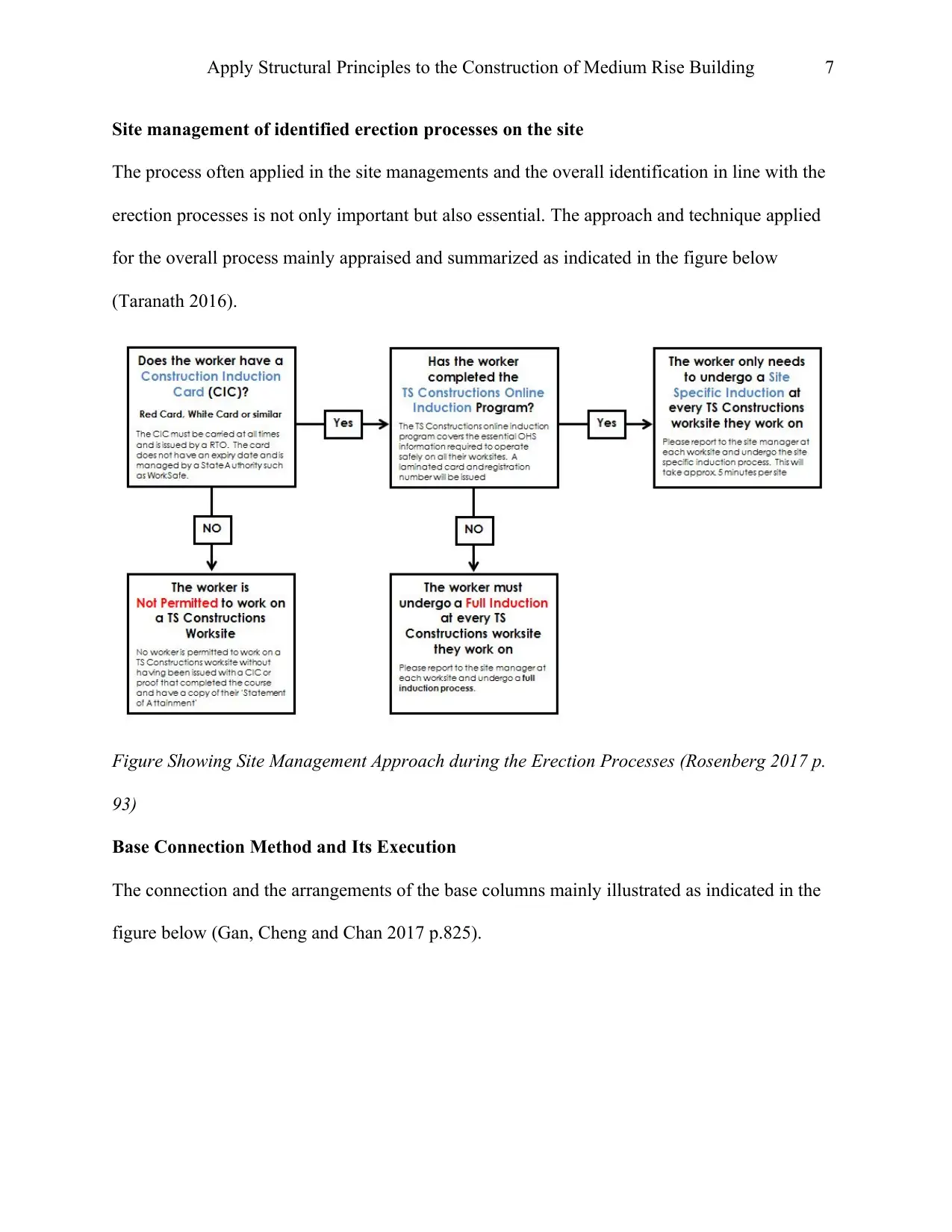
Apply Structural Principles to the Construction of Medium Rise Building 7
Site management of identified erection processes on the site
The process often applied in the site managements and the overall identification in line with the
erection processes is not only important but also essential. The approach and technique applied
for the overall process mainly appraised and summarized as indicated in the figure below
(Taranath 2016).
Figure Showing Site Management Approach during the Erection Processes (Rosenberg 2017 p.
93)
Base Connection Method and Its Execution
The connection and the arrangements of the base columns mainly illustrated as indicated in the
figure below (Gan, Cheng and Chan 2017 p.825).
Site management of identified erection processes on the site
The process often applied in the site managements and the overall identification in line with the
erection processes is not only important but also essential. The approach and technique applied
for the overall process mainly appraised and summarized as indicated in the figure below
(Taranath 2016).
Figure Showing Site Management Approach during the Erection Processes (Rosenberg 2017 p.
93)
Base Connection Method and Its Execution
The connection and the arrangements of the base columns mainly illustrated as indicated in the
figure below (Gan, Cheng and Chan 2017 p.825).
Paraphrase This Document
Need a fresh take? Get an instant paraphrase of this document with our AI Paraphraser
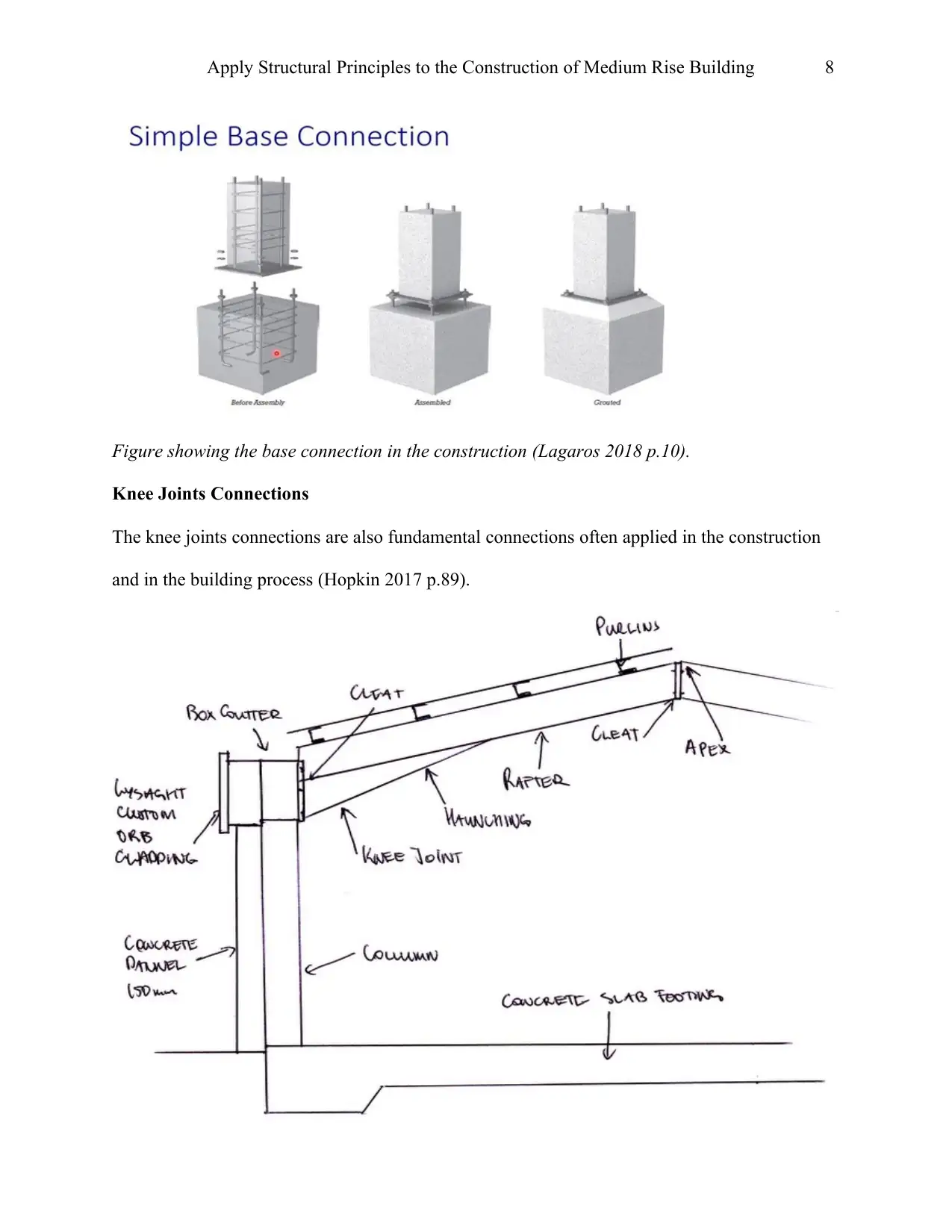
Apply Structural Principles to the Construction of Medium Rise Building 8
Figure showing the base connection in the construction (Lagaros 2018 p.10).
Knee Joints Connections
The knee joints connections are also fundamental connections often applied in the construction
and in the building process (Hopkin 2017 p.89).
Figure showing the base connection in the construction (Lagaros 2018 p.10).
Knee Joints Connections
The knee joints connections are also fundamental connections often applied in the construction
and in the building process (Hopkin 2017 p.89).
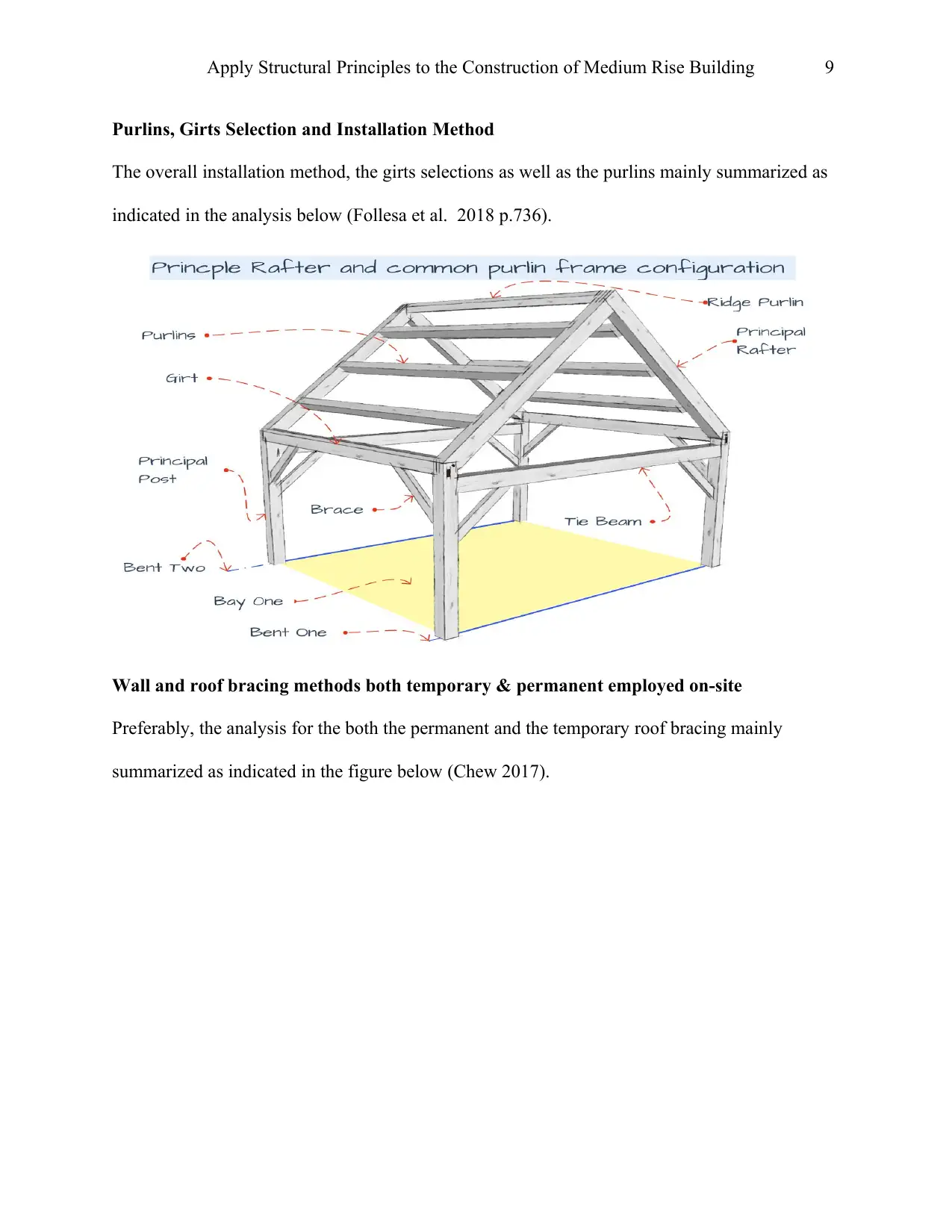
Apply Structural Principles to the Construction of Medium Rise Building 9
Purlins, Girts Selection and Installation Method
The overall installation method, the girts selections as well as the purlins mainly summarized as
indicated in the analysis below (Follesa et al. 2018 p.736).
Wall and roof bracing methods both temporary & permanent employed on-site
Preferably, the analysis for the both the permanent and the temporary roof bracing mainly
summarized as indicated in the figure below (Chew 2017).
Purlins, Girts Selection and Installation Method
The overall installation method, the girts selections as well as the purlins mainly summarized as
indicated in the analysis below (Follesa et al. 2018 p.736).
Wall and roof bracing methods both temporary & permanent employed on-site
Preferably, the analysis for the both the permanent and the temporary roof bracing mainly
summarized as indicated in the figure below (Chew 2017).
⊘ This is a preview!⊘
Do you want full access?
Subscribe today to unlock all pages.

Trusted by 1+ million students worldwide
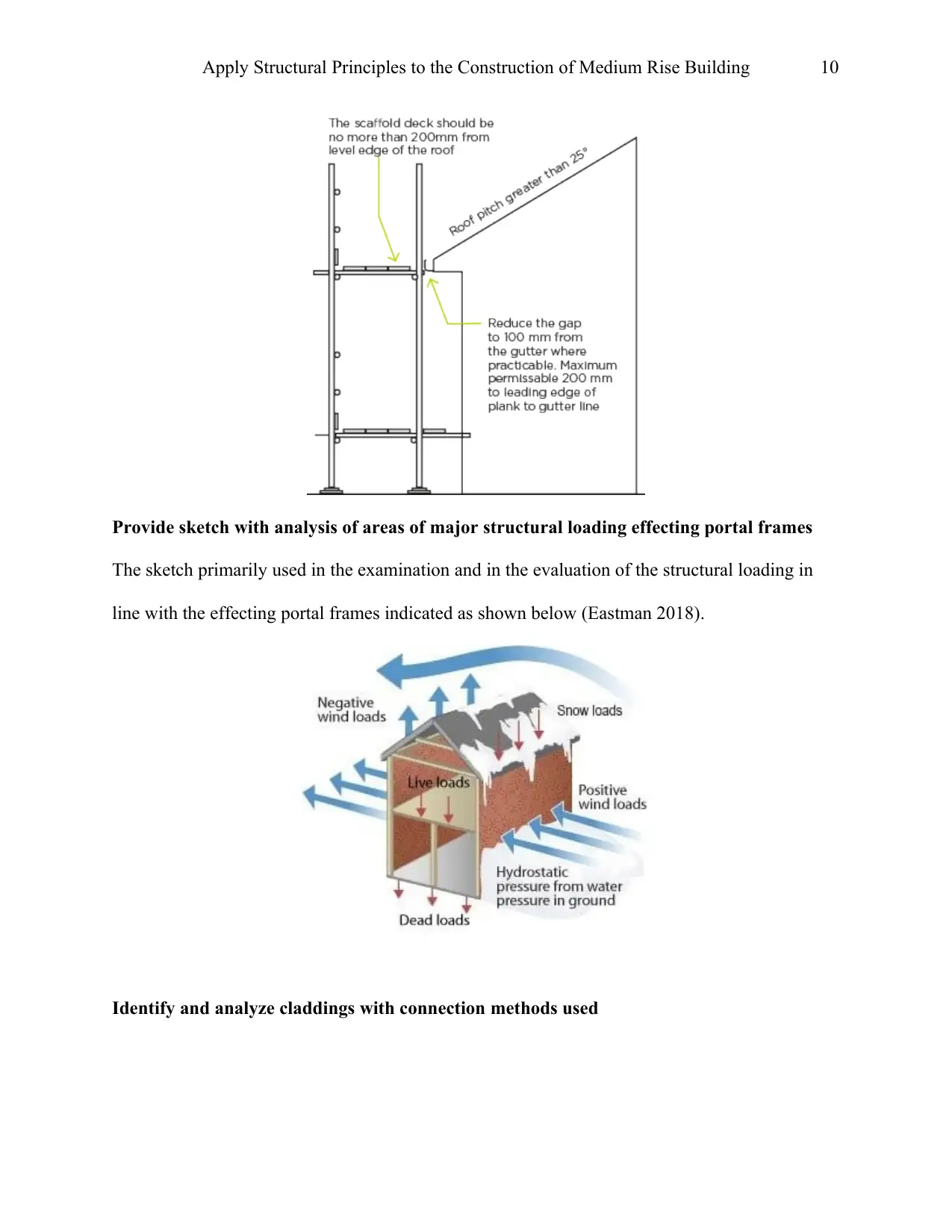
Apply Structural Principles to the Construction of Medium Rise Building 10
Provide sketch with analysis of areas of major structural loading effecting portal frames
The sketch primarily used in the examination and in the evaluation of the structural loading in
line with the effecting portal frames indicated as shown below (Eastman 2018).
Identify and analyze claddings with connection methods used
Provide sketch with analysis of areas of major structural loading effecting portal frames
The sketch primarily used in the examination and in the evaluation of the structural loading in
line with the effecting portal frames indicated as shown below (Eastman 2018).
Identify and analyze claddings with connection methods used
Paraphrase This Document
Need a fresh take? Get an instant paraphrase of this document with our AI Paraphraser
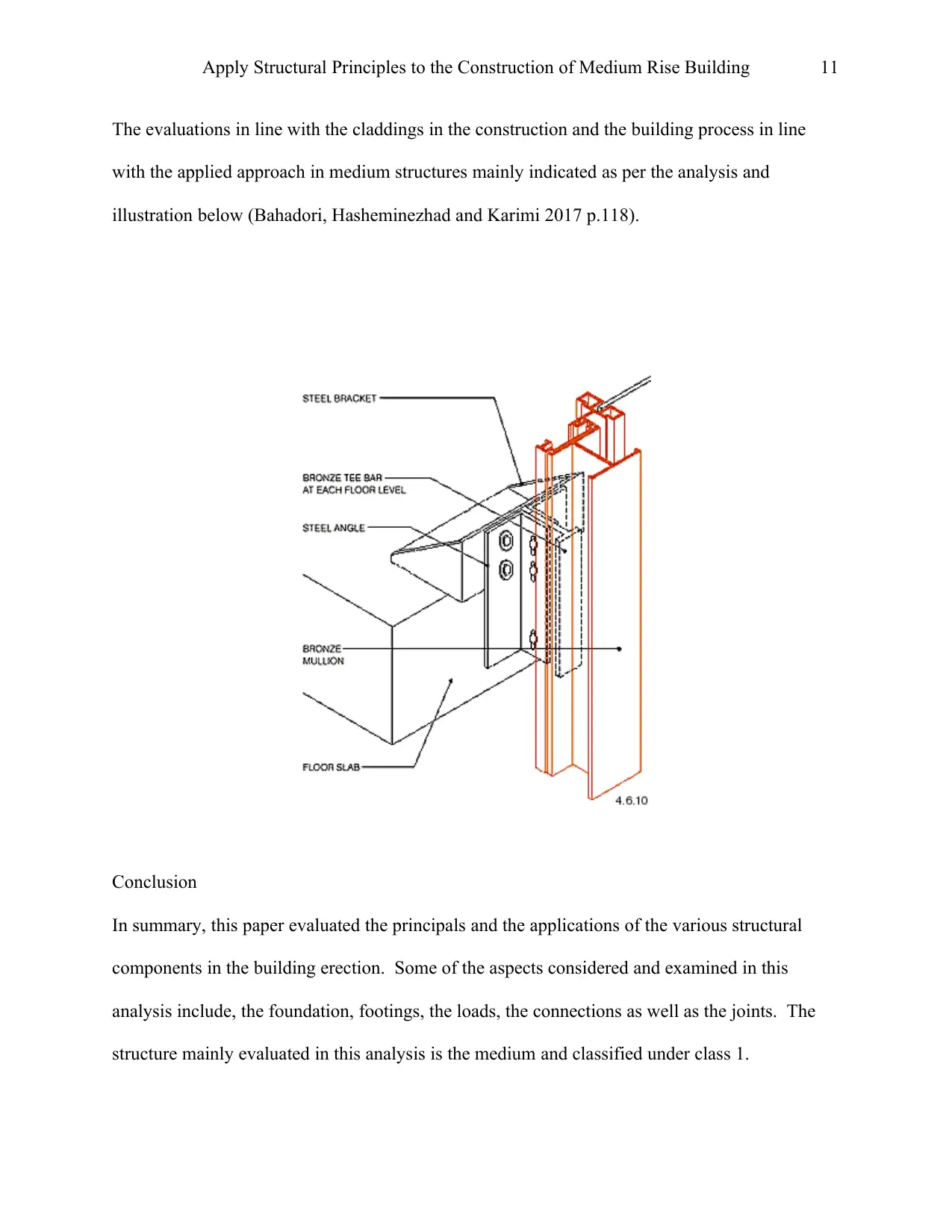
Apply Structural Principles to the Construction of Medium Rise Building 11
The evaluations in line with the claddings in the construction and the building process in line
with the applied approach in medium structures mainly indicated as per the analysis and
illustration below (Bahadori, Hasheminezhad and Karimi 2017 p.118).
Conclusion
In summary, this paper evaluated the principals and the applications of the various structural
components in the building erection. Some of the aspects considered and examined in this
analysis include, the foundation, footings, the loads, the connections as well as the joints. The
structure mainly evaluated in this analysis is the medium and classified under class 1.
The evaluations in line with the claddings in the construction and the building process in line
with the applied approach in medium structures mainly indicated as per the analysis and
illustration below (Bahadori, Hasheminezhad and Karimi 2017 p.118).
Conclusion
In summary, this paper evaluated the principals and the applications of the various structural
components in the building erection. Some of the aspects considered and examined in this
analysis include, the foundation, footings, the loads, the connections as well as the joints. The
structure mainly evaluated in this analysis is the medium and classified under class 1.
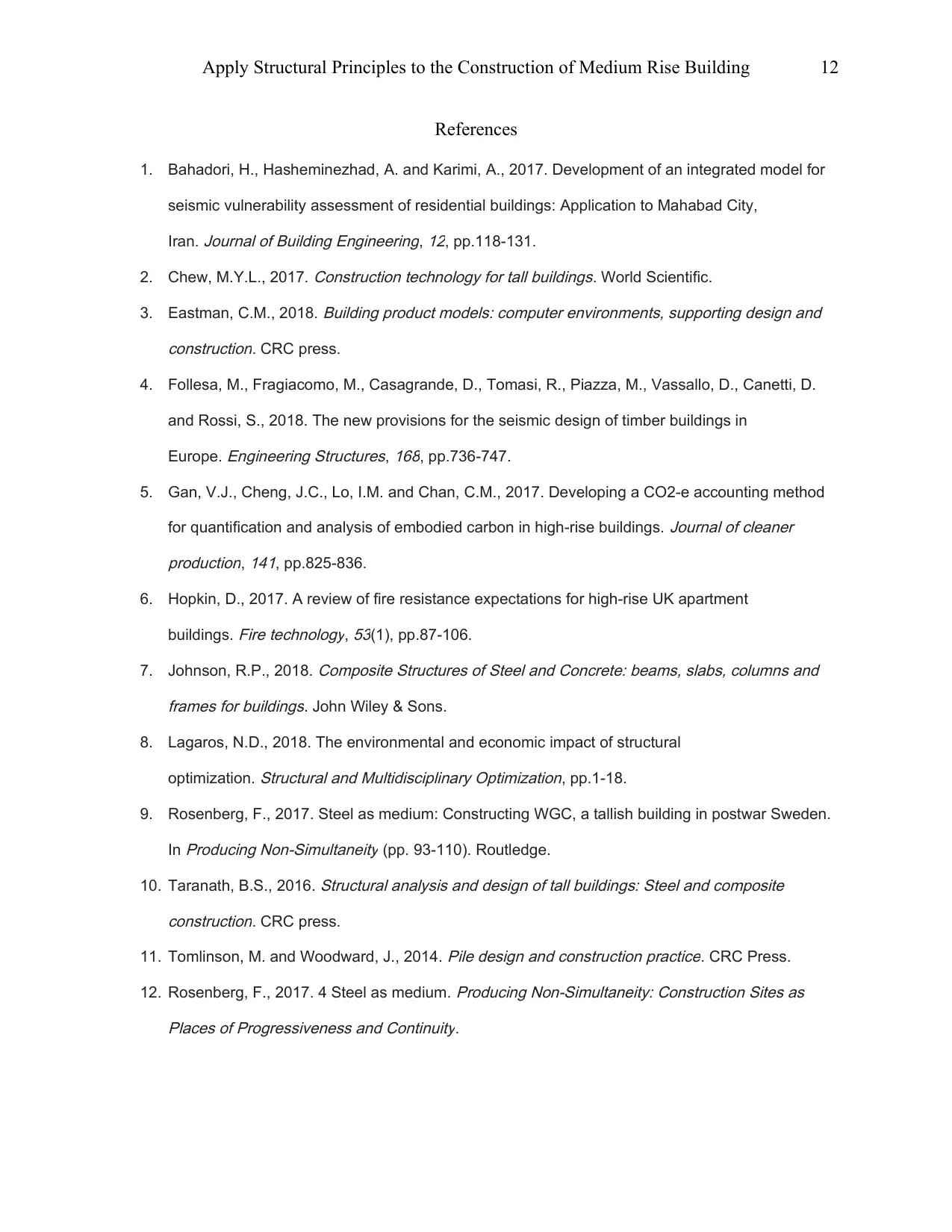
Apply Structural Principles to the Construction of Medium Rise Building 12
References
1. Bahadori, H., Hasheminezhad, A. and Karimi, A., 2017. Development of an integrated model for
seismic vulnerability assessment of residential buildings: Application to Mahabad City,
Iran.
Journal of Building Engineering,
12, pp.118-131.
2. Chew, M.Y.L., 2017.
Construction technology for tall buildings. World Scientific.
3. Eastman, C.M., 2018.
Building product models: computer environments, supporting design and
construction. CRC press.
4. Follesa, M., Fragiacomo, M., Casagrande, D., Tomasi, R., Piazza, M., Vassallo, D., Canetti, D.
and Rossi, S., 2018. The new provisions for the seismic design of timber buildings in
Europe.
Engineering Structures,
168, pp.736-747.
5. Gan, V.J., Cheng, J.C., Lo, I.M. and Chan, C.M., 2017. Developing a CO2-e accounting method
for quantification and analysis of embodied carbon in high-rise buildings.
Journal of cleaner
production,
141, pp.825-836.
6. Hopkin, D., 2017. A review of fire resistance expectations for high-rise UK apartment
buildings.
Fire technology,
53(1), pp.87-106.
7. Johnson, R.P., 2018.
Composite Structures of Steel and Concrete: beams, slabs, columns and
frames for buildings. John Wiley & Sons.
8. Lagaros, N.D., 2018. The environmental and economic impact of structural
optimization.
Structural and Multidisciplinary Optimization, pp.1-18.
9. Rosenberg, F., 2017. Steel as medium: Constructing WGC, a tallish building in postwar Sweden.
In
Producing Non-Simultaneity (pp. 93-110). Routledge.
10. Taranath, B.S., 2016.
Structural analysis and design of tall buildings: Steel and composite
construction. CRC press.
11. Tomlinson, M. and Woodward, J., 2014.
Pile design and construction practice. CRC Press.
12. Rosenberg, F., 2017. 4 Steel as medium.
Producing Non-Simultaneity: Construction Sites as
Places of Progressiveness and Continuity.
References
1. Bahadori, H., Hasheminezhad, A. and Karimi, A., 2017. Development of an integrated model for
seismic vulnerability assessment of residential buildings: Application to Mahabad City,
Iran.
Journal of Building Engineering,
12, pp.118-131.
2. Chew, M.Y.L., 2017.
Construction technology for tall buildings. World Scientific.
3. Eastman, C.M., 2018.
Building product models: computer environments, supporting design and
construction. CRC press.
4. Follesa, M., Fragiacomo, M., Casagrande, D., Tomasi, R., Piazza, M., Vassallo, D., Canetti, D.
and Rossi, S., 2018. The new provisions for the seismic design of timber buildings in
Europe.
Engineering Structures,
168, pp.736-747.
5. Gan, V.J., Cheng, J.C., Lo, I.M. and Chan, C.M., 2017. Developing a CO2-e accounting method
for quantification and analysis of embodied carbon in high-rise buildings.
Journal of cleaner
production,
141, pp.825-836.
6. Hopkin, D., 2017. A review of fire resistance expectations for high-rise UK apartment
buildings.
Fire technology,
53(1), pp.87-106.
7. Johnson, R.P., 2018.
Composite Structures of Steel and Concrete: beams, slabs, columns and
frames for buildings. John Wiley & Sons.
8. Lagaros, N.D., 2018. The environmental and economic impact of structural
optimization.
Structural and Multidisciplinary Optimization, pp.1-18.
9. Rosenberg, F., 2017. Steel as medium: Constructing WGC, a tallish building in postwar Sweden.
In
Producing Non-Simultaneity (pp. 93-110). Routledge.
10. Taranath, B.S., 2016.
Structural analysis and design of tall buildings: Steel and composite
construction. CRC press.
11. Tomlinson, M. and Woodward, J., 2014.
Pile design and construction practice. CRC Press.
12. Rosenberg, F., 2017. 4 Steel as medium.
Producing Non-Simultaneity: Construction Sites as
Places of Progressiveness and Continuity.
⊘ This is a preview!⊘
Do you want full access?
Subscribe today to unlock all pages.

Trusted by 1+ million students worldwide
1 out of 12
Related Documents
Your All-in-One AI-Powered Toolkit for Academic Success.
+13062052269
info@desklib.com
Available 24*7 on WhatsApp / Email
![[object Object]](/_next/static/media/star-bottom.7253800d.svg)
Unlock your academic potential
Copyright © 2020–2025 A2Z Services. All Rights Reserved. Developed and managed by ZUCOL.




